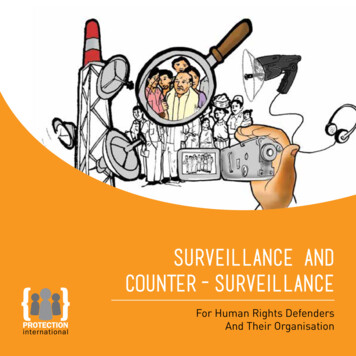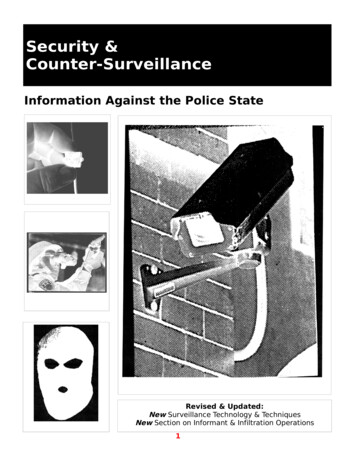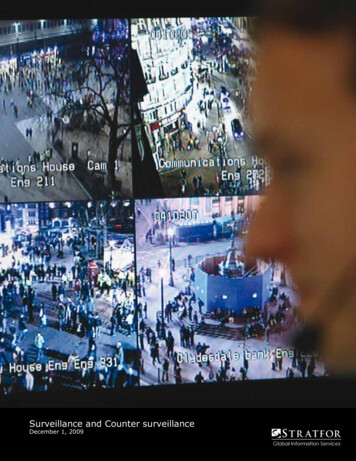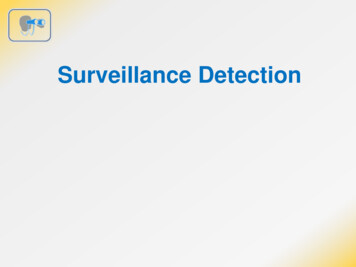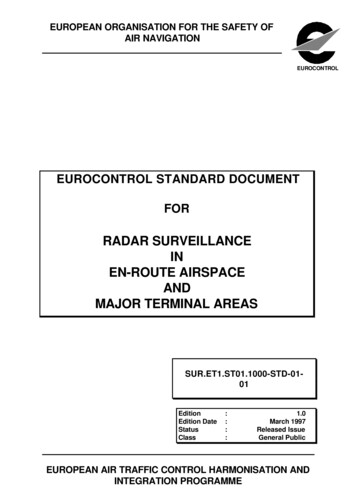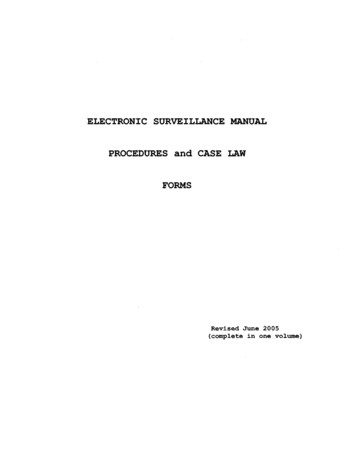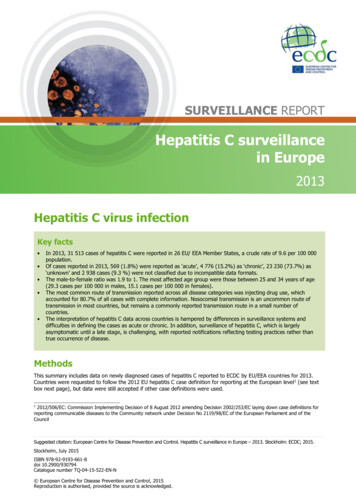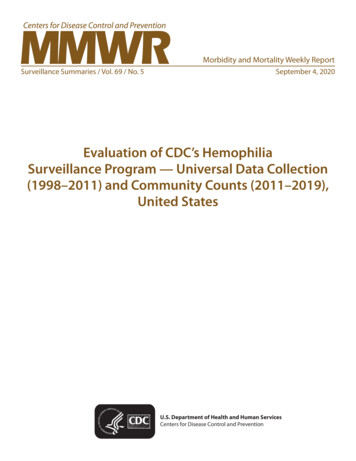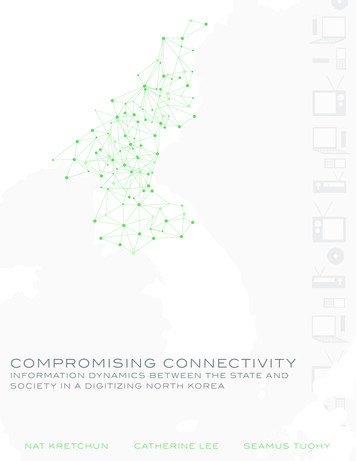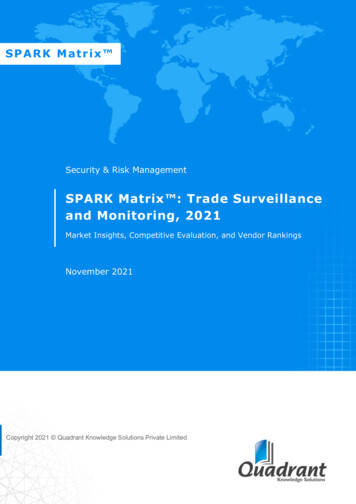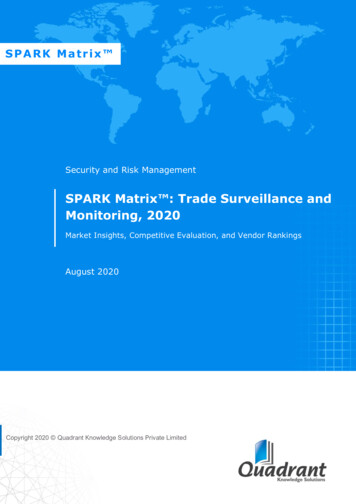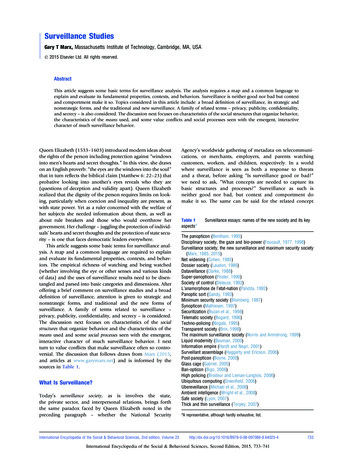
Transcription
Surveillance StudiesGary T Marx, Massachusetts Institute of Technology, Cambridge, MA, USAÓ 2015 Elsevier Ltd. All rights reserved.AbstractThis article suggests some basic terms for surveillance analysis. The analysis requires a map and a common language toexplain and evaluate its fundamental properties, contexts, and behaviors. Surveillance is neither good nor bad but contextand comportment make it so. Topics considered in this article include: a broad definition of surveillance, its strategic andnonstrategic forms, and the traditional and new surveillance. A family of related terms – privacy, publicity, confidentiality,and secrecy – is also considered. The discussion next focuses on characteristics of the social structures that organize behavior,the characteristics of the means used, and some value conflicts and social processes seen with the emergent, interactivecharacter of much surveillance behavior.Queen Elizabeth (1533–1603) introduced modern ideas aboutthe rights of the person including protection against “windowsinto men’s hearts and secret thoughts.” In this view, she drawson an English proverb: “the eyes are the windows into the soul”that in turn reflects the biblical claim (Matthew 6: 22–23) thatprobative looking into another’s eyes reveals who they are(questions of deception and validity apart). Queen Elizabethrealized that the dignity of the person requires limits on looking, particularly when coercion and inequality are present, aswith state power. Yet as a ruler concerned with the welfare ofher subjects she needed information about them, as well asabout rule breakers and those who would overthrow hergovernment. Her challenge – juggling the protection of individuals’ hearts and secret thoughts and the protection of state security – is one that faces democratic leaders everywhere.This article suggests some basic terms for surveillance analysis. A map and a common language are required to explainand evaluate its fundamental properties, contexts, and behaviors. The empirical richness of watching and being watched(whether involving the eye or other senses and various kindsof data) and the uses of surveillance results need to be disentangled and parsed into basic categories and dimensions. Afteroffering a brief comment on surveillance studies and a broaddefinition of surveillance, attention is given to strategic andnonstrategic forms, and traditional and the new forms ofsurveillance. A family of terms related to surveillance –privacy, publicity, confidentiality, and secrecy – is considered.The discussion next focuses on characteristics of the socialstructures that organize behavior and the characteristics of themeans used and some social processes seen with the emergent,interactive character of much surveillance behavior. I nextturn to value conflicts that make surveillance often so controversial. The discussion that follows draws from Marx (2015,and articles at www.garymarx.net) and is informed by thesources in Table 1.What Is Surveillance?Today’s surveillance society, as is involves the state,the private sector, and interpersonal relations, brings forththe same paradox faced by Queen Elizabeth noted in thepreceding paragraph – whether the National SecurityInternational Encyclopedia of the Social & Behavioral Sciences, 2nd edition, Volume 23Agency’s worldwide gathering of metadata on telecommunications, or merchants, employers, and parents watchingcustomers, workers, and children, respectively. In a worldwhere surveillance is seen as both a response to threatsand a threat, before asking “Is surveillance good or bad?”we need to ask, “What concepts are needed to capture itsbasic structures and processes?” Surveillance as such isneither good nor bad, but context and comportment domake it so. The same can be said for the related conceptTable 1aspectsaSurveillance essays: names of the new society and its keyThe panopticon (Bentham, 1995)Disciplinary society, the gaze and bio-power (Foucault, 1977, 1998)Surveillance society, the new surveillance and maximum security society(Marx, 1985, 2015)Net widening (Cohen, 1985)Dossier society (Laudon, 1986)Dataveillance (Clarke, 1988)Super-panopticon (Poster, 1990)Society of control (Deleuze, 1992)L’anamorphose de l’etat-nation (Palidda, 1992)Panoptic sort (Gandy, 1993)Minimum security society (Blomberg, 1987)Synopticon (Mathiesen, 1997)Securitization (Buzan et al., 1998)Telematic society (Bogard, 1996)Techno-policing (Nogala, 1995)Transparent society (Brin, 1998)The maximum surveillance society (Norris and Armstrong, 1999)Liquid modernity (Bauman, 2000)Information empire (Hardt and Negri, 2001)Surveillant assemblage (Haggerty and Ericson, 2006)Post-panopticon (Boyne, 2000)Glass cage (Gabriel, 2005)Ban-opticon (Bigo, 2006)High policing (Brodeur and Leman-Langlois, 2006)Ubiquitous computing (Greenfield, 2006)Ubereveillance (Michael et al., 2008)Ambient intelligence (Wright et al., 2008)Safe society (Lyon, 2007)Thick and thin surveillance (Torpey, 2007)aA representative, although hardly exhaustive, 64025-4International Encyclopedia of the Social & Behavioral Sciences, Second Edition, 2015, 733–741733
734Surveillance Studiesof privacy. Context refers to the type of institution and organization in question and to the goals, rules, and expectations they are associated with. Comportment refers to thekind of behavior expected (whether based on law or lessformal cultural expectations) of, and actually shown by,those in various surveillance roles.While sharing some elements, differences in surveillancecontexts involving coercion (government), care (parents andchildren), contracts (work and consumption) and free-floatingaccessible personal data (the personal and private within thepublic) need consideration. Surveillance is a generic processcharacteristic of living systems with information borders andnot something restricted to governments, spying, or secrecy.Surveillance and privacy are not necessarily in oppositionand the latter can be a means of insuring the former as withaccess controls to information. While media attention to theproblems associated with inappropriate surveillance (particularly by government) is present, there are also problems associated with the failure to use surveillance when it is appropriate.The emerging interdisciplinary field of surveillance studiesanalyzes these issues.Surveillance StudiesThe watchful and potentially wrathful (although also sometimes loving and protective) eye of the Biblical God of theOld Testament offers an early example of surveillance. Moremodern authors include Hobbes, Rousseau, Bentham, Marx,Nietzsche, Weber, and Taylor. Foucault (1977) (althoughwriting about earlier centuries) is the grandfather of contemporary surveillance studies.The field of surveillance studies came to increased publicand academic attention after the events of 9/11 (Monaghan,2006; Ball et al., 2012). But the topic in its modern form hasbeen of interest to scholars at least since the 1950s. This isrelated to greater awareness of the human rights abuses of colonialism, fascism, and communism and anti-democraticbehavior within democratic societies. The literary work of Huxley, Orwell, and Kafka and the appearance of computers andother new technologies with their profound implications forsocial behavior, organization, and society are also factors inthe field’s development.In the form of the surveillance essay current writers frommany disciplines and perspectives (e.g., political economy,social control, law and society, and criminology) draw onand extend the earlier theorists to describe the appearanceof a new kind of society with new forms of social ordering(Table 1).As ideal types, the terms in Table 1 such as the ‘panopticon,’‘disciplinary society,’ or ‘maximum security society’ combinemany strands that need to be separated if we are to movebeyond sweeping claims made about surveillance. Theconcepts discussed in this article seek to bring greater precisionand to add some leaves to the trees. One way to do that is todevelop a middle range approach that fills out a generalconcept such as the maximum security society (as well as mostof the other broad surveillance society naming concepts inTable 1) by identifying subsocieties that compose the surveillance society.The maximum society concept draws parallels to the totalinstitution and the maximum security prison and suggeststhat forms of control traditionally associated with the prisonare diffusing into the broader society. But as an abstractnotion, it does little to analyze variation in surveillance practices and changes over time. To do that the threads of thetapestry must be unwound in a series of subsocieties. Amongcomponents of the contemporary surveillance society are:a hard engineered society; a soft and seductive engineered society;a dossier society; an actuarial society; a transparent society; a selfmonitored society; a suspicious society; a networked society ofambient and ubiquitous sensors in constant communication;a safe and secure society with attenuated tolerance for risk andwith a strong emphasis on prevention; a ‘who are you society?’of protean identities, both asserted by and imposed uponindividuals; and a ‘where are you, where have you been, andwho else is there?’ society of documented mobility, activity,and location. The broad approach of the surveillance essaysis important in calling attention to contemporary changes,but such work generally does not take us beyond broad statements, does not adequately define surveillance, nor identifycomponents that would systematically permit differentiatingthe new from the old forms, or making comparisons betweenvarious surveillance uses, contexts, and societies. In offeringneither inclusive and nuanced definitions nor adequatelyelaborating dimensions, they fail to call attention to what isuniversal in human societies or to offer ways to analyzewhat is different.Defining SurveillanceThe English noun surveillance comes from the French verb surveillir. It is related to the Latin term vigilare with its hint thatsomething vaguely sinister or threatening lurks beyond thewatchtower and town walls. Still, the threat might be successfully warded off by the vigilant. This ancient meaning is reflected in the association many persons still make ofsurveillance with the activities of police and national securityagencies. Yet in contemporary society the term has a far widermeaning.What is surveillance? The dictionary, thesaurus, and popularusage suggest a set of related activities: look, observe, watch,supervise, control, gaze, stare, view, scrutinize, examine,checkout, scan, screen, inspect, survey, glean, scope, monitor,track, follow, spy, eavesdrop, test, or guard. While some ofthese are more inclusive than others and can be logically linked(e.g., moving from look to monitor), and while we might teaseout subtle and distinctive meanings for each involving a particular sense, activity, or function, they all reflect what the philosopher Ludwig Wittgenstein calls a family of meanings withinthe broader concept.At the most general level surveillance of humans (which isoften, but need not be synonymous with human surveillance)can be defined as regard or attendance to others (whethera person, a group, or an aggregate as with a national census)or to factors presumed to be associated with these. A centralfeature is gathering some form of data connectable to individuals (whether as uniquely identified or as a member ofa category).International Encyclopedia of the Social & Behavioral Sciences, Second Edition, 2015, 733–741
Surveillance StudiesA verb such as ‘observe’ is not included in the definitionbecause the nature of the means (or the senses involved)suggests subtypes and issues for analysis and ought not to beforeclosed by a definition (e.g., how do visual, auditory, text,and other forms of surveillance compare with respect to factorssuch as intrusiveness or validity?). If such a verb is needed, to‘scrutinize,’ ‘regard,’ or ‘attend to’ is preferable to observe,with its tilt toward the visual.Many contemporary theorists offer a narrower definitiontied to the goal of control (e.g., Dandeker, 1990; Lyon,2001; Manning, 2008; Monahan, 2010). Taking a cue fromFoucault’s earlier writings, control as domination is emphasized (whether explicitly or implicitly) rather than as a morepositive direction or neutral discipline. Yet, as Lianos (2003)observes, the modern role of surveillance as control must beplaced in perspective alongside its fundamental importancein enhancing institutional efficiency and services.Surveillance – particularly as it involves the state and organizations, but also in role relationships as in the family –commonly involves power differences and on balance favorsthe more powerful. Understanding this is furthered withcomparisons to settings where control and domination arenot central as with other goals such as surveillance for protection, entertainment, or contractual relations; where surveillance is reciprocal; and where it does not only, or necessarily,flow downward or serves to disadvantage the subject.Authority and power relations are closely related to theability to collect and use data. The conditions for accessingand using information are elements of a democratic society(Haggerty and Samatas, 2010). The greater the equality insubject–agent settings, the more likely it is that surveillancewill be bilateral. Given the nature of social interaction anda resource-rich society with civil liberties, there is appreciabledata collection from below as well as from above and alsoacross settings. Reciprocal surveillance can also be seen inmany hierarchal settings.Mann et al. (2003) refer to watchfulvigilance from below as sousveillance.The definition of surveillance as hierarchical watching overor social control is inadequate. The broader definition offeredhere is based on the generic activity of surveilling (the takingin of data). It does not build in the goal of control, nor specifydirectionality. In considering current forms we need to appreciate bidirectionality and horizontal as well as vertical directions. Control needs to be viewed as only one of manypossible goals and/or outcomes of surveillance. When this isacknowledged, we are in a position to analyze variation andnote factors that may cut across kinds of surveillance.In his analysis of “The Look” Sartre (1993) capturesa distinction between nonstrategic and strategic surveillance. Hedescribes a situation in which an observer is listening frombehind a closed door while peeking through a keyhole when“all of a sudden I hear footsteps in the hall.” He becomes awarethat he himself will now be observed. In both cases he isinvolved in acts of surveillance, but these are very differentforms. In the latter case he simply responds and draws a conclusion from a state of awareness. In the former he has taken theinitiative, actively and purposively using his senses.Nonstrategic surveillance refers to the routine, autopilot,semiconscious, often even instinctual awareness in which oursense receptors are at the ready, constantly receiving inputs735from whatever is in perceptual range. Smelling smoke orhearing a noise that might or might not be a car’s backfire areexamples. In contrast, strategic surveillance involves a consciousstrategy to gather information. This may be in a cooperative oradversarial setting – contrast parents watching a toddler withcorporations intercepting each other’s telecommunications.Within the strategic form, which to varying degrees ferretsout what is not freely offered, we can identify two mechanismsintended to create (or prohibit) conditions of visibility andlegibility: material tools that enhance (or block) the sensesand rules about the surveillance itself. While these are independent of each other, they show common linkages, as with rulesrequiring reporting when there are no available tools fordiscovery or rules about the conditions of use for tools thatare available. A stellar example is the ‘Lantern Laws’ that prohibited slaves from being out at night unless they carrieda lantern (Browne, 2015). Here, the emphasis is on requiringthe subject to make him or herself visible given the limitationsbrought by darkness. But note also efforts to alter environmentsto make them more visible as with the creation of ‘defensiblespace’: via taking down shrubs or using glass walls (Newman,1972) or less visible ala the architecture of bathrooms.Within the strategic form we can distinguish traditionalfrom the new surveillance. Examples of the new surveillanceinclude computer matching and profiling, big data sets, videocameras, DNA analysis, GPS, electronic work monitoring,drug testing, and the monitoring made possible by socialmedia and cell phones. The new surveillance tends to bemore intensive, is extensive, extends the senses, is based onaggregates and big data, has lower visibility, involves involuntary (often categorical) compliance of which the subject may beunaware, tends to decrease cost, and reach remote locations.While the historical trend here is clear, it is more difficult togeneralize about other characteristics such as whether or notsurveillance has become more deceptive or more difficult todefeat than previously. Many forms are more omnipresentand often presumed to be omnipotent.The new surveillance may be defined as scrutiny of individuals, groups, and contexts through the use of technical meansto extract or create information. In this definition the use of ‘technical means’ to extract and create the information implies theability to go beyond what is naturally offered to the senses andminds unsupported by technology, or what is voluntarily reported. Many of the examples extend the senses and cognitiveabilities by using material artifacts, software, and automatedprocesses, but the technical means for rooting out can also involvesophisticated forms of manipulation, seduction, coercion, deception, infiltrators, informers, and special observational skills.Including ‘extract and create’ in the definition calls attentionto the new surveillance’s interest in overcoming the strategic orlogistical borders that inhibit access to personal information.These inhibitors may involve willful hiding and deception onthe part of subjects or limits of the natural world, senses, andcognitive powers. Create also suggests that data reflect theoutput of a measurement tool. The tool itself reflects a decisionabout what to focus on and the results are an artifact of the waythey were constructed. Of course, constructions vary in theirusefulness, validity, and reliability. Our perceptions of theempirical world are conditioned by where and how we lookand these may vary in their fidelity to that world.International Encyclopedia of the Social & Behavioral Sciences, Second Edition, 2015, 733–741
736Surveillance StudiesThe use of ‘contexts’ along with ‘individuals’ recognizes thatmuch modern surveillance attends to settings, or patterns ofrelationships and groups, beyond focusing on a given, previously identified individual. Meaning may reside in crossclassifying discrete sources of data (as with computer matchingand profiling) that, when considered separately, are notrevealing. Systems as well as persons are of interest. The collection of group data or the aggregation of individual into groupdata offers parameters against which inferences about individuals are drawn for purposes of classification, prediction, andresponse. Depending on the parameters, this may bring rationality and efficiency, but there is an inferential leap in goingfrom group characteristics based on past events to future predictions about a given individual.This definition of the new surveillance excludes the routine,nontechnological surveillance that is a part of everyday life,such as looking before crossing the street or seeking the sourceof a sudden noise or an unusual scent. It also excludes theroutine attentiveness to, and interaction with, others that isfundamental to being a social being (as with mannerlybehavior such as opening the door for another or offeringa seat to an elderly person). An observer on a nude beach orpolice interrogating a cooperative suspect would also beexcluded, because in these cases the information is volunteeredand the unaided senses are sufficient.Related but Distinct: Surveillance and Privacy,Privacy, and PublicityHow do surveillance and privacy relate? Surveillance is oftenwrongly seen to be the opposite of privacy. Kelvin (1973)emphasized this role of privacy as a nullification mechanismfor surveillance. But at the most basic level, surveillance issimply a way of discovering and noting data that may be converted to information. Thus, depending on the context and roleplayed, individuals or groups may be required, find it optional,or be prohibited from engaging in these activities, whether assubjects or agents of surveillance and communication. Thisobviously can involve invasions of privacy, as it was with theemployee in a lab testing for AIDS who sold information onpositive results to a mortuary.Yet surveillance can also be the means of protecting privacy.Consider biometric identification and audit trails required touse some databases, or defensive measures such as a homesecurity video camera. Privacy for whom, surveillance ofwhom, by whom, and for what reasons need to be specified.Privacy like surveillance is a multidimensional conceptwhose contours are often ill-defined, contested, negotiated,and fluid, dependent on the context and culture. Among themajor forms are informational (Westin, 1967), aesthetic(Rule et al., 1980), decisional (Decew, 1997), and proprietary(Allen, 2007) privacy. Informational privacy (Westin, 1967)is the most significant and contested contemporary form andinvolves the rules and conditions around personalinformation.Breaches of decisional or proprietary privacy involve application or use of private information, rather than informationdiscovery. While distinct, informational privacy shares withthe other forms the key factor of control over access to theperson or at least the person’s data and the forms may betemporally connected. Thus, if individuals can control theirpersonal information – whether not having to reveal theirpurchase of birth control pills (when this was illegal) orkeeping paparazzi from taking pictures – they need not worryabout that information being used.Informational privacy encompasses physical privacy. Thelatter can refer to insulation resulting from natural conditionssuch as walls, darkness, distance, skin, clothes, and facialexpression. These can block or limit outputs and inputs. Bodilyprivacy is one form of this, and its borders can be crossed byimplanting something such as a chip or birth control deviceor removing something, such as tissue, fluid, or a bullet. Withininformational privacy we find the conditions of anonymity andpseudo-anonymity, often referred to as being necessary foranother type of privacy involving seclusion and being leftalone. Personal information borders are obviously more difficult to cross if an individual cannot be reached via name orlocation.Informational privacy can be considered as it ties to institutional setting (e.g., financial, educational, health, welfare,employment, criminal justice, national security, voting, andcensus); places and times; the kind of data involved, such asabout religion or health; participant roles; and aspects of technology and media, such as audio or visual, wire or wireless,print, phone, computer, radio, or TV. Considerations of setting,location, time, data type, and means are central to legislationand regulation and rich in anomalies and cross-culturaldifferences.A concept related to privacy is publicity. The two can belinked within the same framework. The common elementsare rules about the protection and revelation of information.In some countries such as Canada the same officials are responsible for privacy and for freedom of information. In the firstcase there are rules giving individuals the right to control theirpersonal information and in the second rules requiring thatinformation not be restricted – that is, that it be made public.While sharing elements, for policy purposes there are majordifferences between the privacy of individuals and the secrecyof organizations. The standards for the latter should not automatically be applied to the former.As nouns privacy and publicity can be seen as polar ends ofa continuum involving rules about withholding and disclosing,and seeking or not seeking, information. Thus, depending onthe context and role played, individuals or groups may berequired, find it optional, or be prohibited from engaging inthese activities, whether as subjects or agents of surveillanceand communication.When the rules specify that a surveillance agent is not to askcertain questions of (or about) a person and the subject hasdiscretion about what to reveal, we can speak of privacy norms.When the rules specify that the subject must reveal the information or the agent must seek it, we can speak of publicity norms(or, better perhaps, disclosure norms). With publicity normsthere is no right to personal privacy that tells the agent not toseek information, nor does that give the subject discretionregarding revelation. Rather, the reverse – the subject has anobligation to reveal and/or the agent to discover (Marx, 2011).The moral expectations surrounding information asa normative phenomenon (whether for protection as withInternational Encyclopedia of the Social & Behavioral Sciences, Second Edition, 2015, 733–741
Surveillance Studiesprivacy or revelation as with publicity and whether based onlaw, policy, or custom) can be differentiated from the empiricalstatus of the information as known or unknown. To understand this distinction, we need the related terms, private andpublic – adjectives that can tell us about the status of information. Is information known or unknown, does it have an objective quality, can it be relatively easily measured? For example,in face-to-face encounters one generally knows the genderand face of a stranger, whether this is in the street, an office,or a home. The information is ‘public’ as in readily accessible,and this may be supported by anti-mask laws and requirementsto wear symbolic items of clothing, tattoos, or badges. Absentsuch rules, the stranger’s political or religious beliefs are morelikely to be invisible and unknown.Normative expectations of privacy and publicity do notalways correspond to how the adjectives public and privateare applied to empirical facts. Thus, the cell phone conversations of politicians and celebrities that have privacy protectionsmay become public. Information subjected to publicityrequirements such as government and corporate reports anddisclosure statements may be withheld, destroyed, or falsified.Information not entitled to privacy protections, such as child orspouse abuse, may be unknown because of the inaccessibilityof the home to broader visibility. The distinction calls forempirical analysis of the variation in the fit between the rulesabout information and what actually happens to it.Privacy and publicity can be thought of in literal and metaphorical spatial terms involving invisibility–visibility and inaccessibility–accessibility. The privacy offered by a closed door ora wall and an encrypted e-mail message share informationrestriction, even as they differ in many other ways. Internetforums are not geographically localized, but in their accessibility can be usefully thought of as public places, not unlikethe traditional public square where exchanges with others arepossible or where others are visible as with open architecture.Erving Goffman (1971) in writing of ‘relations in public’ and‘public life’ attends to the elements and possibilities withinthe immediacy of physical copresence. This is the strand of‘publicness’ as visibility. It suggests the ‘public’ as known toat least one other person rather than to any rules about thestatus of information (that it must be revealed or concealedor to a legally defined place such as private golf course) asnoted above. Thus, we can paradoxically speak of ‘public orderin private places’ (Goffman, 1971: XIV).We can also speakabout expectations of the private even within the public(Nissenbaum, 1998; Marx, 2001). In the latter case, since theinformation is available (such as with someone’s appearanceor a conversation overheard in a restaurant). But limits remainas with expectations about not staring or listening too closely towhat others nearby are saying.Structures and ProcessesRegardless of whether we are dealing with traditional or thenew surveillance, some common classificatory notions can beapplied. In the case of surveillance social structures, forexample, we can identify the surveillance agent (whether ), while theperson about whom information is sought or reported is the737surveillance subject. The agent role can be further separatedinto the sponsor, data collector, and initial or secondary user.Many contemporary concerns over surveillance involve thepractices of large organizations relative to employees, clients, orthe public. Organizational surveillance is distinct from the nonorganizational surveillance carried about by individuals. At theorganizational level, formal surveillance involves a constituency. Organizations have varying degrees of internal andexternal surveillance (Rule, 1973). Erving Goffman (1961)has identified many kinds of employee or inmate monitoring,such as within ‘total institutions.’Within an organization internal constituency surveillance(scrutiny of insiders as with work monitoring) contrasts withexternal constituency surveillance (attending to outsiders such ascustomers, patients, and travelers). External nonconstituencysurveillance involves organizations monitoring their broaderenvironment in watching other organization
Surveillance and privacy are not necessarily in opposition and the latter can be a means of insuring the former as with access controls to information. While media attention to the problems associated with inappropriate surveillance (particu-larly b
